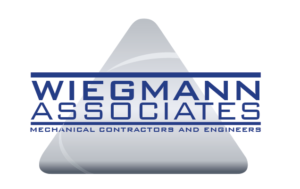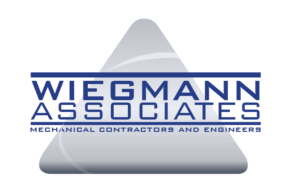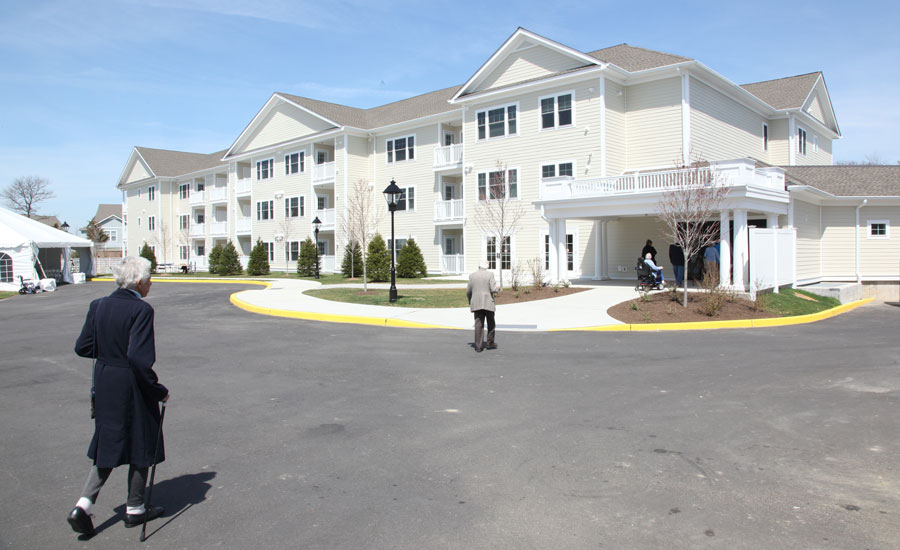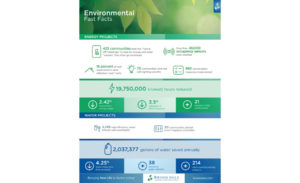You’ve no doubt heard about the “graying of America.” According to the National Institutes of Health, by 2030, about 20 percent of the U.S. population or approximately 72 million individuals will be over the age of 65. The seniors housing industry is gearing up to meet this demographic growth, and, in the process, creating new opportunities for the HVAC industry.
Although many people may think seniors housing means nursing homes, independent and assisted living communities are also important parts of the equation. Assisted living facilities combine elements of health care and hospitality, and the number of these communities is growing nationwide. According to the National Center for Assisted Living, there are 30,200 assisted living communities with 1 million licensed beds in the U.S. today. Typical services provided at these communities include 24-hour supervision and assistance; exercise, health, and wellness programs; housekeeping and maintenance; meals and dining services; medication management or assistance; personal care services; and transportation.
The owners and operators of these communities are tasked with not only meeting their residents’ comfort needs but also achieving increasingly important sustainability goals.
SUSTAINABILITY IS A PRIORITY
Sustainability is a priority for Brookdale Senior Living Inc., which operates more than 1,000 communities in 46 states. The company issues an annual report that encompasses its sustainability focus areas and priorities.
“Energy savings is a big part of our sustainability program because it’s good for the planet and the bottom line, but that is not the only motivation,” said Marla Thalheimer, Brookdale’s director of sustainability. “Sustainability matters to our key stakeholders, including residents and their families, associates, and investors.”
Sustainability is also important to Brookdale’s associates, especially the millennial workforce.
“[Our associates] care about the environment and want to work for a company that cares,” Thalheimer said. “We have amazing associates in our communities today who help to make a difference.”
One of the most important sustainability measures Brookdale has taken is benchmarking energy usage in the U.S. Environmental Protection Agency’s (EPA’s) Energy Star Portfolio Manager, according to Thalheimer.
“This tool helps us understand the level of efficiency of each community and then helps us identify where the most opportunities for improvement are, so we can prioritize resources accordingly,” she said.
The 2017 Sustainability Report noted 214 Brookdale communities completed retrocommissioning surveys on HVAC and basic building systems in 2016. These surveys identified savings that resulted in 993 corrective action/conservation measures to increase efficiency and enhance comfort. Thalheimer said auditing and retrocommissioning of its facilities is an extremely valuable process because it provides important information not only on opportunities specific to those communities but also on common themes across the company’s entire portfolio.
“For example, we make sure all our communities have programmable thermostats in our common areas, so we can do nighttime setbacks,” she said. “We have to be sensitive because our communities operate 24/7, but even a slight tweak is still a good efficiency measure we can take advantage of. Our results are positive, and we are continuously saving energy over our 2015 baseline. We still have work to do, but we are on the right path.”
What can HVAC contractors do to make themselves valuable sustainability partners with senior living providers such as Brookdale? Thalheimer said for dedicated sustainability projects, Brookdale looks for HVAC contractors who not only have great expertise but are also willing to work with the company to develop solutions.
“This works best when it is a partnership and not just a ‘check the box’ kind of job,” she said.
Finally, Brookdale looks for contractors who understand the senior living business — that residents come first and foremost at all times — and have a high level of respect when they are in any Brookdale community.
“I’ve heard of contractors who are working in our communities that will stop and take a moment to help a resident,” Thalheimer said. “Those are the kind of people we love to work with.”
TAKING PRIDE IN LEED CERTIFICATION
Peconic Landing is a continuing care retirement community in Greenport, New York. Its 144-acre campus is made up of 109 cottages and 187 apartments for residential independent living as well as assisted-living apartments and accommodations for skilled nursing, short-term rehabilitation, and memory support.
The community’s expansion independent living apartment building earned Leadership in Energy and Environmental Design (LEED) Platinum-certification from the U.S. Green Building Council (USGBC) in December 2016, and its Health Center building, which houses the community’s short-term rehab and memory support areas, received LEED Silver-certification in July 2017.
“We want to ensure we are being good neighbors by embracing environmental stewardship opportunities,” said Robert J. Syron, president and CEO of Peconic Landing. “While LEED certification is a good example of that commitment, our sustainability efforts are ongoing. We have an active and engaged group of members who continue to advocate for ‘living green.’”
Steve Carroll, Peconic Landing’s CFO, said one of the challenges of creating a comfortable yet highly efficient environment at a seniors housing campus is that seniors often have a different tolerance for ambient temperatures than younger people do. Therefore, they tend to value comfort over conservation.
“Because of their lower tolerance to being too hot or too cold, seniors can be very demanding when it comes to heating and cooling,” Carroll said. “Investing in a high-efficiency system helped us meet our residents’ comfort needs in a cost-effective manner.”
Darryl Volinski, director of environmental services at Peconic Landing, said one benefit of being LEED certified is the pride the residents take in living in a green community. From his point of view, an added benefit of going through the LEED process was having another set of eyes on the project. The USGBC’s LEED for Homes program requires project teams to work with third-party raters from the design phases throughout construction and final commissioning.
“On a big project, like our expansion apartment building, a lot of things can be missed, so to have the LEED Green Raters here making sure everything was up to par was a big positive,” he said. “The testing they did to ensure we were insulated properly and the equipment met LEED criteria made me comfortable that our residents were going to be comfortable.”
The heating and cooling at Peconic Landing’s apartment building is supplied by high-efficiency (96.5 AFUE) furnaces and 16-SEER condensing units for each apartment. Rooftop units (RTUs) with variable-speed compressors serve the common areas. The apartments meet whole-house ventilation requirements with continuously operating Energy Star bathroom exhaust fans. The Health Center’s resident rooms are served by variable-refrigerant-flow (VRF) fan coil units, and the center also features high-efficiency condensing boilers for domestic hot water and a high-efficiency closed-loop cooling tower.
“Due to the nature of its layout and connection to the existing building, the Health Center was more difficult to air seal and perform well during the blower door tests,” said Karla Butterfield, sustainability director with Steven Winter Associates, the LEED for Homes provider. “The process is rigorous and requires collaboration from the entire design and construction team. Plans and specifications were reviewed to ensure strategies were implemented to reduce energy, water, and material consumption, as well as to increase the indoor air quality and experience of the occupants. Inspections were made during construction, energy modeling was used to evaluate systems, and the building was final tested and verified to ensure performance.”
The team at Peconic Landing had the foresight to realize LEED certification was just the beginning, and the community would need to properly maintain the systems to ensure they remained efficient in the future.
To that end, the community hired mechanical consultant Michael Katzmark, owner of Control Solutions Inc., North Haven, Connecticut.
Katzmark said remote monitoring is a key to not only optimizing system operation but also keeping the system operating trouble-free for the residents.
“If the system has a fault, it sends an email to me, Darryl, and the building maintenance department,” he said, “Our goal is to address any problem before the residents even notice it.”
Katzmark added that, in addition to keeping the equipment properly maintained and monitored, mechanical contractors can provide another valuable service to operators of senior living facilities: good communication.
“Many of the problems that can be encountered on a project of this size — some of which don’t show up until the commissioning process — can be avoided simply by keeping good lines of communication open from the HVAC contractors, to the general contractor, to the end user,” he said.
A CONTRACTOR’S PERSPECTIVE
Grant Wiegmann, account executive at Wiegmann Associates, a national design/build HVAC contractor that has built more than 20 senior living projects in five states, said the assisted living sector is a strong market for the company.
According to Wiegmann, the key to the company’s success in the seniors housing market is understanding and anticipating the unique needs of assisted living organizations. For example, contractors often need to be proactive in suggesting sustainable solutions, even if the client isn’t asking for them initially.
“Part of our role at Wiegmann is to educate clients on the value of sustainability and energy efficiency, since 50 percent of the HVAC life cycle cost is devoted to energy usage,” Wiegmann said. “Thus, we put a sharp pencil to construction budgets, but we also think far beyond first costs to energy efficiency and long-term maintenance.”
Assisted living clients demand consistent and reliable HVAC systems that provide comfort, noise control, and ease of use, according to Wiegmann. Both common areas and residents’ private spaces must be draft-free and comfortable, with controls that are simple to operate. Since these are essentially residences, it’s also important to look for ways to reduce HVAC noise and humidity and to design systems to maximize valuable interior space.
Although assisted living clients have some unique needs that combine the challenges of both residential and commercial HVAC, the basic tenets of good contracting still hold true in these facilities.
“For all clients, we believe it’s important to go beyond basic HVAC design and construction by providing a range of services from value engineering and automation controls to energy cost-saving analysis and recommendations to preventive maintenance programs and ongoing facility service,” Wiegmann said.
The senior living industry is offering many options to help people age independently, with assistance, and, when necessary, with care. HVAC contractors would be well-advised to examine how they can help these communities meet their goals. Those who do may find that there’s quite a bit of gold in those golden years.



